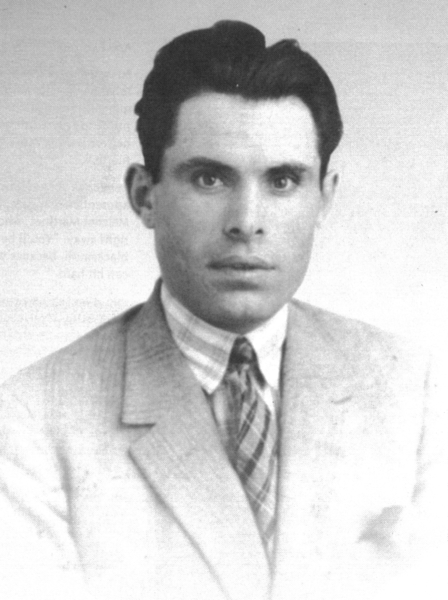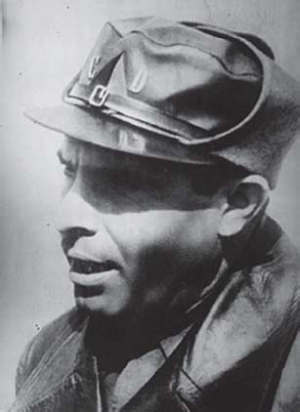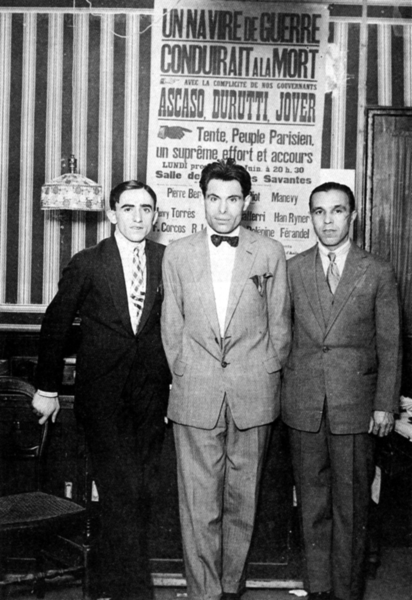<Back to Index>
- Spanish Anarchist Jose Buenaventura Durruti Dumange, 1896
PAGE SPONSOR



José Buenaventura Durruti Dumange (14 July 1896 – 20 November 1936) was a central figure of Spanish anarchism during the period leading up to and including the Spanish Civil War.
Durruti was born in León, Spain, son of Anastasia Dumangue and Santiago Durruti, a railway worker in the yard at Leon who described himself as a libertarian socialist. Buenaventura was the second of eight brothers (one was killed in the October 1934 uprising in the Asturias, another died fighting the Fascists on the Madrid front).
In 1910, aged 14, Durruti left school to become a trainee mechanic in the railway yard in León. Like his father, he joined the socialist Unión General de Trabajadores (UGT) union. In 1917 he took an active part in the strike of August 1917 called by the UGT when the government overturned an agreement between the union and the employers. The government brought in the Spanish Army to suppress the strike; they killed 70 people and injured more than 500 workers. 2,000 of the strikers were imprisoned without trial or legal process. Durruti managed to escape, but had to flee abroad to France where he came into contact with exiled anarchists. The brutality of the Spanish State had a profound and lasting effect on the young Durruti. From the fall of 1917 until the beginning of 1920, Durruti worked in Paris as a mechanic. He then decided to return to Spain and arrived at San Sebastian, Basque Country, just across the border. Here, he was introduced to local anarchists such as Suberviola, Ruiz, Aldabatrecu or Marcelino del Campo, with whom he formed the anarchist armed struggle group Los Justicieros ("The Avengers"). In 1921, during the inauguration of the Great Kursaal in San Sebastian, members of this group attempted unsuccessfully to murder King Alfonso XIII. Shortly after Buenasca, the then President of the recently formed anarchist controlled Confederacion Nacional del Trabajo CNT, persuaded Durruti to go to Barcelona to organize the workers there where the anarchist movement, as well as the syndicalists, was being brutally suppressed and most of its members jailed or executed. Here, with Juan García Oliver, Francisco Ascaso, and other members of Los Justicieros, he founded Los Solidarios ("Solidarity"). In 1923 the group was also implicated in the assassination of Cardinal Juan Soldevilla y Romero, as a reprisal for the killing of an anarcho - syndicalist union activist Salvador Seguí. After Miguel Primo de Rivera seized power in Spain in 1923, Durruti and his comrades organized attacks on the military barracks in Barcelona and on the border stations near France. These attacks were unsuccessful and quite a few anarchists were killed. Following these defeats, Durruti, Ascaso and Oliver fled to Latin America. They subsequently traveled widely, visiting Cuba and carrying out bank robberies in Chile and Argentina.
Durrutiwith his companions returned to Spain and Barcelona, becoming an influential militant within two of the largest anarchist organizations in Spain at the time, the Federación Anarquista Ibérica (FAI), and of the anarcho - syndicalist trade union Confederación Nacional del Trabajo (CNT). The influence Durruti's group gained inside the CNT caused a split, with a reformist faction under Ángel Pestaña leaving in 1931 and subsequently forming the Syndicalist Party.
Working closely with his comrades in the FAI and CNT Durruti helped to co-ordinate armed resistance to the military rising of Francisco Franco, an effort which was to prove vital in preventing General Goded's
attempt to seize control of Barcelona. During the battle for the
Atarazanas Barracks, Durruti's long time comrade and closest friend
Ascaso was shot dead. Less than a week later, on 24 July 1936 Durruti
led over 3,000 armed anarchists (later to become known as the Durruti Column) from Barcelona to Zaragoza. After a brief and bloody battle at Caspe (in Aragón), they halted at Pina de Ebro, on the advice of a regular army officer, postponing an assault on Zaragoza.
On 12 November, having been persuaded to leave Aragón by the anarchist leader Federica Montseny on behalf of the government, Durruti led his militia to Madrid to aid in the defense of the city. On 19 November, he was shot while leading a counter attack in the Casa de Campo area. According to author Antony Beevor (The Spanish Civil War, 1982), Durruti was killed when a companion's machine pistol went off by mistake. At the time, the anarchists lied and claimed he had been hit by an enemy sniper's bullet "for reasons of morale and propaganda".
Another account of Durruti's death, given in Durruti: The People Armed by Abel Paz, claims that rather than being shot by a fellow soldier he was killed by distant gunfire coming from the area around the Clinical Hospital in University City (Madrid), which had been taken over by Nationalist forces. After a fight to regain control and contact was re-established with troops cut off from communications, Durruti returned temporarily to the Miguel - Angel barracks to issue orders. A message from Liberto Roig arrived informing Durruti that the Clinical Hospital was in the process of being evacuated. Alarmed, he asked his Chauffeur Julio Grave to get his car and leave immediately for the Hospital. His chauffeur gives the following testimonial:
We passed a little group of hotels which are at the bottom of this avenue (Queen Victoria Avenue) and we turned towards the right. Arriving at the big street, we saw a group of militiamen coming towards us. Durruti thought it was some young men who were leaving the front. This area was completely destroyed by the bullets coming from the Clinical Hospital, which had been taken during these days by the Moors and which dominated all the environs. Durruti had me stop the car which I parked in the angle of one of those little hotels as a precaution. Durruti got out of the auto and went towards the militiamen. He asked them where they were going. As they didn't know what to say, he ordered them to return to the front. The militiamen obeyed and Durruti returned towards the car. The rain of bullets became stronger. From the vast red heap of the clinical Hospital, the Moors and the Guardia Civil were shooting furiously. Reaching the door of the machine, Durruti collapsed, a bullet through his chest.
He
died on 20 November 1936, in a makeshift operating theater set up in
what was formerly the Ritz Hotel at the age of 40. The bullet was lodged
in the heart, and the diagnosis was "death caused by pleural
hemorrhage". The doctors wrote a report in which the path of the bullet
and the character of the wound was recorded but not the caliber of the
bullet, since they hadn't removed it and there was no autopsy.
"It is we the workers who built these palaces and cities here in Spain and in America and everywhere. We, the workers, can build others to take their place. And better ones! We are not in the least afraid of ruins. We are going to inherit the earth; there is not the slightest doubt about that. The bourgeoisie might blast and ruin its own world before it leaves the stage of history. We carry a new world here, in our hearts."— Buenaventura Durruti
Durruti's body was transported across country to Barcelona for his funeral. Over a half million people filled the streets to accompany the cortege during its route to the Montjuïc Cemetery. It was the last large scale public demonstration of anarchist strength of numbers during the bitter and bloody Civil War.
Hugh Thomas remarks: “the death of Durruti marked the end of the classic age of Spanish Anarchism. An Anarchist poet proclaimed that Durruti’s nobility while living would cause ‘a legion of Durrutis’ to spring up behind him.”